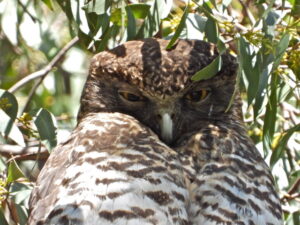
Powerful owl photographed on one of our Landcare properties. Powerful owls can eat a whole brush tailed possum in the breeding season.

Powerful owl photographed on one of our Landcare properties. Powerful owls can eat a whole brush tailed possum in the breeding season.
Working on a beautiful property in Balnarring, honouring Malcolm’s vision. Cleaning up around the dam and weeding around plants planted alongside the creek fenceline at a working bee in May 2019.
The Western Linkage Biolink plan focuses on the works required to achieve the Western Linkage on private properties. Four private properties are covered in the Plan. Additional complementary works on public land in the biolink alignment (including South East Water Treatment Plant, Mt Martha, and The Briars Park, Mt Martha) are also covered in the Plan, but not in as much detail as these works were already planned and underway prior to the Bay to Bay Biolink project.
Western Linkage Biolink Plan*
Western Linkage Appendix 3A: Western linkage works on private land – actions required and indicative costings*
*Landholder names have been redacted for privacy reasons.
If you are a landholder in the Watson Creek biolink area or the Sheepwash Creek biolink area, we invite you to join us. Become an active contributor to this initiative and restore a section of your land to benefit local wildlife. Enjoy watching the fruits of your labour in the future. Meet your neighbours as you learn more about the landscape you live in.
The success of this exciting project will depend on the involvement of landholders – the more people become involved, the better the outcome!
If you are a landholder in the Watson Creek biolink area or the Sheepwash Creek biolink area, we invite you to join us by:
An ecologist with expertise in local vegetation and wildlife can visit you on your property. This is an opportunity to ask questions about areas on your property that you believe may be suitable for inclusion in the biolink.
Join your neighbours on a short field trip of either the Watson Creek biolink area or the Sheepwash Creek biolink area, followed by a social lunch/afternoon tea. An ecologist with expertise in local vegetation and wildlife will provide expert commentary on the anticipated challenges and opportunities of the proposed biolink.
You will have the opportunity to hear from local landholders who have participated in biolink projects by reserving sections of their properties for native wildlife. You will work with your neighbours to put together a local biolink plan. A local ecologist will be on hand to advise about the value of different types of vegetation and areas for wildlife.
Linking the Mornington Peninsula Landscape will support Landcare groups, in the catchments covered by the project to work with landholders on biolinks.
Contact us to get started.
As a landholder, hosting a section of biolink on your property means setting aside a portion of your land for native vegetation. What benefits can flow from this?